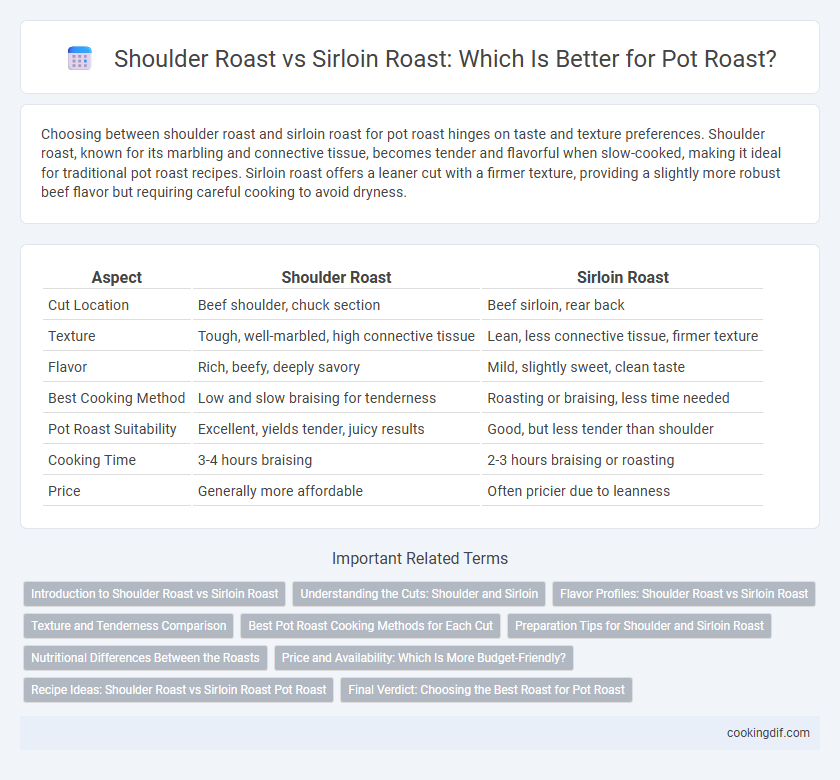Choosing between shoulder roast and sirloin roast for pot roast hinges on taste and texture preferences. Shoulder roast, known for its marbling and connective tissue, becomes tender and flavorful when slow-cooked, making it ideal for traditional pot roast recipes. Sirloin roast offers a leaner cut with a firmer texture, providing a slightly more robust beef flavor but requiring careful cooking to avoid dryness.
Table of Comparison
| Aspect | Shoulder Roast | Sirloin Roast |
|---|---|---|
| Cut Location | Beef shoulder, chuck section | Beef sirloin, rear back |
| Texture | Tough, well-marbled, high connective tissue | Lean, less connective tissue, firmer texture |
| Flavor | Rich, beefy, deeply savory | Mild, slightly sweet, clean taste |
| Best Cooking Method | Low and slow braising for tenderness | Roasting or braising, less time needed |
| Pot Roast Suitability | Excellent, yields tender, juicy results | Good, but less tender than shoulder |
| Cooking Time | 3-4 hours braising | 2-3 hours braising or roasting |
| Price | Generally more affordable | Often pricier due to leanness |
Introduction to Shoulder Roast vs Sirloin Roast
Shoulder roast, also known as chuck roast, offers a well-marbled, flavorful cut ideal for slow cooking methods like pot roast, resulting in tender, juicy meat. In contrast, sirloin roast provides a leaner option with a firmer texture, requiring careful cooking to avoid dryness but delivering robust beef flavor. Both cuts are popular choices for pot roast, with shoulder roast generally preferred for its tenderness and sirloin roast favored for a leaner meal.
Understanding the Cuts: Shoulder and Sirloin
Shoulder roast, also known as chuck roast, comes from the upper part of the front leg and contains more connective tissue and marbling, making it ideal for slow-cooking methods like pot roast to achieve tender, flavorful meat. Sirloin roast, sourced from the rear back portion, tends to be leaner with less connective tissue, resulting in a firmer texture that requires precise cooking to avoid dryness. Choosing between shoulder and sirloin for pot roast depends on whether you prioritize richer, melt-in-your-mouth tenderness or a leaner cut with a beefier bite.
Flavor Profiles: Shoulder Roast vs Sirloin Roast
Shoulder roast offers rich, beefy flavors with a higher fat content that enhances tenderness and moisture during slow cooking, making it ideal for pot roast. Sirloin roast provides a leaner, slightly milder taste with a firmer texture, delivering a more delicate and beef-forward flavor in comparison. Choosing between these cuts depends on whether you prefer a fattier, more robust flavor or a leaner, refined beef essence in your pot roast.
Texture and Tenderness Comparison
Shoulder roast offers a rich, well-marbled texture that breaks down into tender, flavorful meat ideal for slow-cooked pot roast. Sirloin roast, while leaner, provides a firmer texture with moderate tenderness, requiring careful cooking to prevent dryness. The shoulder cut's higher collagen content results in a more succulent, melt-in-the-mouth experience compared to the slightly chewier sirloin.
Best Pot Roast Cooking Methods for Each Cut
Shoulder roast, known for its marbling and connective tissue, excels with slow cooking methods like braising or slow roasting to break down collagen and achieve tender, flavorful pot roast. Sirloin roast, leaner and more tender, benefits from moderate roasting or sous vide techniques to retain moisture without overcooking. Choosing the right cooking method enhances each cut's texture and flavor, making shoulder best for low and slow, while sirloin suits gentler, controlled heat for pot roast dishes.
Preparation Tips for Shoulder and Sirloin Roast
Shoulder roast requires slow cooking at low temperatures to break down its tough connective tissues, resulting in tender, flavorful pot roast, and it benefits from marinating or seasoning with herbs like rosemary and garlic. Sirloin roast, being leaner and more tender, cooks faster and suits medium heat preparation; it is essential to avoid overcooking by searing first to lock in juices and maintaining moisture with broth or wine. Using a heavy pot or Dutch oven for both cuts ensures even heat distribution and enhances the tenderness and flavor of the pot roast.
Nutritional Differences Between the Roasts
Shoulder roast offers higher collagen content, making it ideal for slow-cooking and richer in protein and iron, supporting muscle repair and oxygen transport. Sirloin roast contains less fat and fewer calories, providing a leaner option with more zinc and B vitamins, crucial for immune function and energy metabolism. Choosing between shoulder and sirloin roasts affects the nutritional profile of pot roast, balancing between tenderness, fat content, and micronutrient density.
Price and Availability: Which Is More Budget-Friendly?
Shoulder roast is generally more budget-friendly than sirloin roast due to its higher availability and lower demand, making it a cost-effective choice for pot roast. Sirloin roast, although leaner and tender, tends to be pricier and less commonly found in grocery stores. For budget-conscious cooks, shoulder roast offers better value without sacrificing flavor or texture in slow-cooked dishes.
Recipe Ideas: Shoulder Roast vs Sirloin Roast Pot Roast
Shoulder roast offers rich marbling and connective tissue, making it ideal for slow cooking methods like pot roast, yielding tender, flavorful meat perfect for recipes with root vegetables and savory herbs. Sirloin roast, leaner and firmer, suits quicker roasting or braising, delivering a beefier taste while maintaining a slightly firmer texture, ideal for recipes that incorporate bold spices and wine reductions. Choosing between shoulder and sirloin roast depends on desired tenderness and cooking time, influencing recipe adaptations to enhance each cut's unique flavor and texture.
Final Verdict: Choosing the Best Roast for Pot Roast
Shoulder roast, known for its rich marbling and connective tissue, becomes tender and flavorful when slow-cooked, making it ideal for pot roast. Sirloin roast offers leaner meat with a firmer texture but may require careful cooking to avoid dryness. For the best pot roast experience, shoulder roast is preferred due to its superior juiciness and melt-in-your-mouth tenderness after slow braising.
Shoulder Roast vs Sirloin Roast for Pot Roast Infographic

 cookingdif.com
cookingdif.com